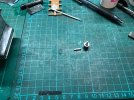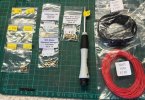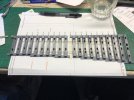Hayfield1
Western Thunderer
John,
Re the solder, good to hear, I was surprised by Ken’s suggestion.
re the threadlocker, be careful, it can be just as bad. David LO Smith published an article about repairing threadlocked wheels, he had to re-bore the crankpin holes using a milling machine. Possible, but a load of unnecessary work! I don’t have threadlocker on any of mine, if they’re nipped up, they should stay put. If they don’t, it’s probably worth fixing the source of the problem rather than the symptom.
Your little 0-4-0 is a nice bit of work!
cheers
Simon
Simon
Thank you, its been great fun building it, sadly in the repair shop waiting for a new (correct) set of gears. Its getting nearer the paint shop, but also waiting for the steps. I have another Manning Wardle on eBay very cheap as its missing lots of parts, but if I don't sell it soo I will keep it and do a bit of kit bashing. I put as many parts that I could find from the lot I brought. I could raid my own spares which would reduce what's required to build it
The 45xx (which this discussion is about) is proving just as enjoyable and interesting I have not had the time to read up but did these early 45xx's have short or tall funnels please






















